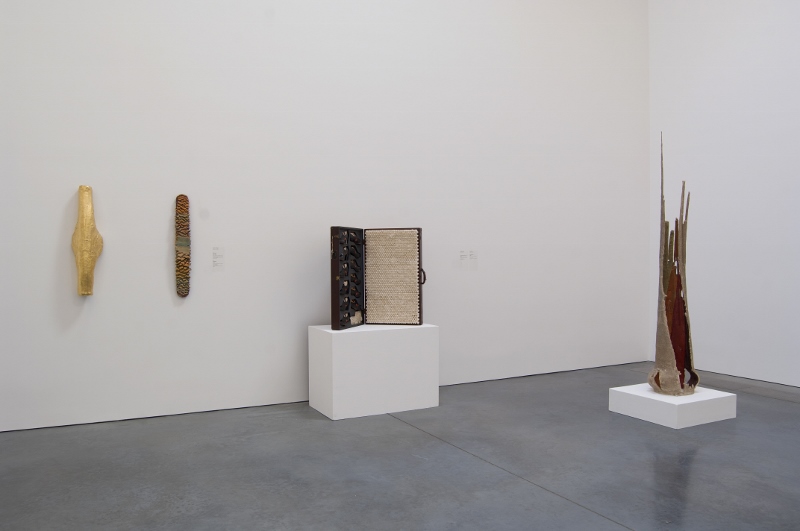The works of art brought together in this gallery represent a loose confederation of artists who share an interest in the materiality of the object and its social and symbolic functions. Betty Parson’s career as a gallery owner and advocate for art and artists is legendary. Less well known is her own work, which has notable affinities with the “primitive” art that she and her artists, including Jackson Pollock and Alfonso Ossorio, readily embraced. In 1946 Parsons inaugurated a new gallery space with an exhibition of Northwest Coast Indian painting and the lure of diverse cultures held lifelong appeal. She also assembled sculptures from the scraps of wood that washed up on the beach near her house on the North Fork overlooking Long Island Sound. Parsons remained closed to Ossorio, whose estate The Creeks on Georgica Pond in Wainscott was a gathering place for many artists, including Lousie Nevelson. Nevelson’s compositions of found wooden objects, stacked and painted, transform everyday materials into objects of beauty. Her artistic kinship with Ossorio is evident in the bold “Congregations” he began to make in the 1960s—vast assemblages of horns, antlers, eyes, shells, bones, teeth, and assorted plastic forms—that established his reputation as a visionary artist. His friend the painter Joseph Glasco, a visitor at The Creeks during this time, created tiny dioramas that are windows onto a world made of pigment, glitter and jewels.
Lynda Benglis’s art practice explores the body and materiality through intricate sculptural processes and the creation of biomorphic forms. A lozenge-shaped wall piece is built up from layers of wax and resin dripped onto a Masonite support, creating a “frozen gesture.” Spiraclereferences the breathing holes on the outer skeleton of insects; the artist makes the awkward form elegant with the application of gold leaf. Donald Lipski has a Surrealists’s eye for bringing found objects to life by joining them in odd combinations, exploring how this unexpected context imparts new meaning to the materials. The traveling salesman-style case stuffed with women’s shoes and white candles encourages the viewer to make his or her own free associations. Mel Kendrick uses paint and color as a distinct material, a second skin which he applies to the sculpture. The medium he uses here, Japan color, has a luscious matte surface, a heavy pigment load, and pure rich color with a semi-paste consistency. “I very much like the idea of using what you have at hand with its inherent limitations. It’s not like I have to run out and get something new. There’s a way of finding it in myself.”
The artist Ry Rocklen makes sculptures from cast-off objects—here a torn windsock found lying on the street. He stretched the materials over a cone-shaped armature, covered it with paper mâché and then pressed sand into the surface. When he removed the fabric from the form, it ripped and tore, resulting in the shape that remains. He titled the sculpture Sunday Spire. “I like to bring the object back,” he has said, “giving it a second, more poetic life.”
The Permanent Collection 2015. Art. Illuminated. is made possible, in part, by the generous support of Maren Otto, the Joseph and Sylvia Slifka Foundation, Suzanne and Bob Cochran, Linda and Gregory Fischbach, Christopher Harland and Ashley Leeds, Calvin Klein Family Foundation, Melva Bucksbaum and Raymond Learsy, and Galerie Lelong. The Museum’s programs are made possible, in part, by the New York State Council on the Arts with the support of Governor Andrew M. Cuomo and the New York State Legislature, and by the property taxpayers from the Southampton School District and the Tuckahoe Common School District.


